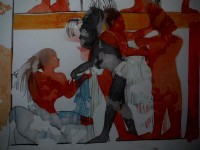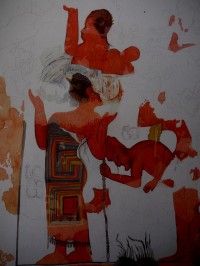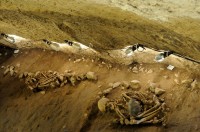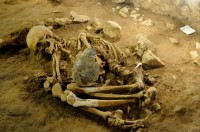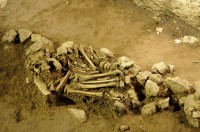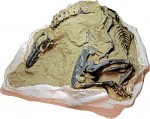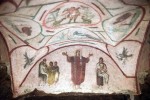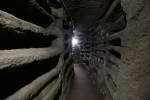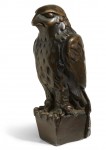 The Maltese Falcon sold for $3,500,000 ($4,085,000 including buyer’s premium) at a Bonhams auction in New York today. It was part of a sale of movie memorabilia curated in conjunction with the eminent film nerds of the Turner Classic Movies cable channel, source of all high-density bottlenecks on my DVR. This particular falcon was one of two surviving lead props made for the classic movie starring Humphrey Bogart as Dashiell Hammett’s private investigator Sam Spade.
The Maltese Falcon sold for $3,500,000 ($4,085,000 including buyer’s premium) at a Bonhams auction in New York today. It was part of a sale of movie memorabilia curated in conjunction with the eminent film nerds of the Turner Classic Movies cable channel, source of all high-density bottlenecks on my DVR. This particular falcon was one of two surviving lead props made for the classic movie starring Humphrey Bogart as Dashiell Hammett’s private investigator Sam Spade.
When I first wrote about the sale of the iconic Black Bird, I mistakenly thought this example was the second lead prop made by artist Fred Sexton after the first was damaged during shooting. In fact, the one that sold today is the one that was damaged. It has a bent tail garnered in an epic incident on the set.
One of the Taplinger memos [, Robert S. Taplinger was Warner Bros.’ Director of Publicity,] mentions a significant incident during filming of the finale: actress Lee Patrick (as Spade’s secretary Effie, the woman who delivers the falcon to his apartment) dropped the statuette while handing it over to Bogart. Bogart pushed Patrick out of the way of the falling bird, but in so doing his own foot caught the brunt of the falcon’s weight, causing him to injure two toenails. The right tail feather of the falcon was reportedly damaged in the fall, and the damage is visible as Sam carries the bird out of his apartment at the end of the film
 The stuff that dreams are made of, as Spade described the bird, was the star of the auction, but there were a number of other wonderful pieces. Leaf through the catalog to spot your favorite. I defy you not to swoon at the 1940 Buick Phaeton from Casablanca that was so
The stuff that dreams are made of, as Spade described the bird, was the star of the auction, but there were a number of other wonderful pieces. Leaf through the catalog to spot your favorite. I defy you not to swoon at the 1940 Buick Phaeton from Casablanca that was so 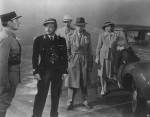 prominently featured in the immortal final scenes of the movie. This is the vehicle in which Renault drives Rick, Ilsa and Victor to the airport. The “here’s looking at you” final dialogue between Rick and Ilsa takes place next to the car. It unexpectedly sold for $380,000, below the low estimate of $450,000.
prominently featured in the immortal final scenes of the movie. This is the vehicle in which Renault drives Rick, Ilsa and Victor to the airport. The “here’s looking at you” final dialogue between Rick and Ilsa takes place next to the car. It unexpectedly sold for $380,000, below the low estimate of $450,000.
 On the less expensive end of things, I was charmed by a portrait of Harpo Marx as Gainsborough’s Blue Boy painted by John Decker in the 1930s. It sold for $9,500. Mary Pickford’s monogrammed Louis Vuiton trunk went for $2,600, a steal for vintage Vuiton with Mary Pickford’s initials emblazoned on the side while Mr. Vuiton’s were discretely relegated to the brass locks. It was a subtler time for high fashion.
On the less expensive end of things, I was charmed by a portrait of Harpo Marx as Gainsborough’s Blue Boy painted by John Decker in the 1930s. It sold for $9,500. Mary Pickford’s monogrammed Louis Vuiton trunk went for $2,600, a steal for vintage Vuiton with Mary Pickford’s initials emblazoned on the side while Mr. Vuiton’s were discretely relegated to the brass locks. It was a subtler time for high fashion.
 It wasn’t just the older classics represented. Indy’s braided leather bullwhip from Indiana Jones and the Last Crusade was bought for $8,000. A can of new! delicious Soylent Green, ostensibly the “miracle food of high energy plankton gathered from the oceans of the world” but I get the feeling they might be leaving out a key ingredient, went for $1,800. It comes with a Soylent Green cracker which is actually a piece of painted balsa wood. Movie magic, y’all.
It wasn’t just the older classics represented. Indy’s braided leather bullwhip from Indiana Jones and the Last Crusade was bought for $8,000. A can of new! delicious Soylent Green, ostensibly the “miracle food of high energy plankton gathered from the oceans of the world” but I get the feeling they might be leaving out a key ingredient, went for $1,800. It comes with a Soylent Green cracker which is actually a piece of painted balsa wood. Movie magic, y’all.
 From the sexy days of pre-code silent films, the snake headdress and pyramid earrings worn by Theda Bara in the 1917 Fox version of Cleopatra sold for $28,000. I wonder if her impressive risqué snake bra has survived. It reminds of Princess Lea’s famous gold bikini
From the sexy days of pre-code silent films, the snake headdress and pyramid earrings worn by Theda Bara in the 1917 Fox version of Cleopatra sold for $28,000. I wonder if her impressive risqué snake bra has survived. It reminds of Princess Lea’s famous gold bikini 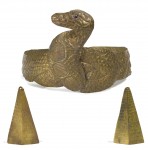 from Return of the Jedi, only Theda’s version offers significantly less coverage.
from Return of the Jedi, only Theda’s version offers significantly less coverage.
My favorite non-Bogey lot is a 1929 nude portrait of Clara Bow painted by Hungary artist Geza Kende. The portrait was commissioned by a far more famous Hungarian, Bela Lugosi, when he was still treading the boards.
In 1929, Lugosi was touring the United States appearing in the play Dracula, soon to be optioned by Universal for a film adaptation. One of the audience members at a Los Angeles performance was the silent film star Clara Bow. Sound films had recently taken hold in Hollywood and Bow was anxious about whether her thick Brookyln accent would appeal to audiences. Having read in the press that Lugosi spoke his lines phonetically without knowing English, Bow was determined to find out more about the Hungarian actor. Bow biographer
David Stenn describes their meeting: “Clara sat transfixed through Dracula, and when the final curtain fell, she made a beeline for Lugosi’s dressing room. ‘How d’ya know your lines?’ she immediately asked him. Lugosi, who still spoke no English, gesticulated that he learned from cues by other actors. Without further ado, Clara invited him home'”
Clara Bow was so game. I love her. Oh, and her accent is basically non-existent, to modern ears anyway. Here she is in 1932’s Call Her Savage:
[youtube=http://youtu.be/AHzWqUS0d0E&w=430]
The painting sold for $24,000.
